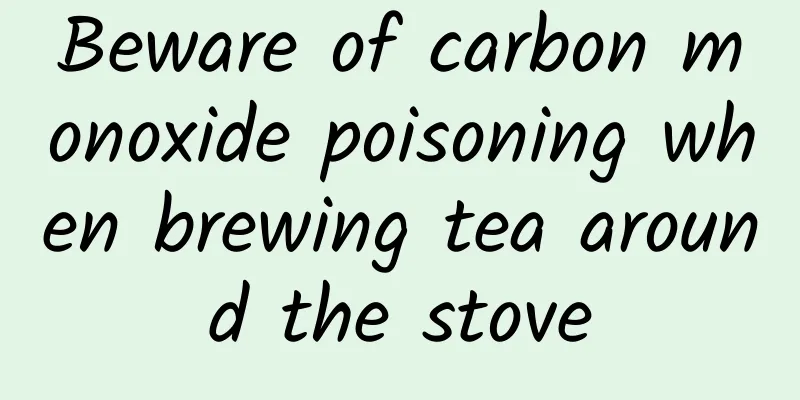Beware of carbon monoxide poisoning when brewing tea around the stove

|
In recent years, "cooking tea around the stove" has gradually become a "net celebrity". Warm the cold winter "cook the years lightly, brew tea slowly". The winter atmosphere is set off by the hot stove with teapots, chestnuts, roasted persimmons, etc. However, there are hidden risks behind this warm and romantic scene. This is acute carbon monoxide poisoning. Carbon monoxide is called the "invisible killer". It is colorless, odorless and non-irritating. Poor ventilation can cause a decrease in oxygen content, resulting in incomplete combustion of carbon-containing substances and the production of carbon monoxide. When the carbon monoxide in the house increases to a certain concentration, it can cause poisoning, commonly known as gas poisoning. Carbon monoxide will replace oxygen and combine with hemoglobin in the blood to form carboxyhemoglobin, which makes the blood lose its oxygen transport capacity, leading to tissue hypoxia and inhibition of cell respiration, and in severe cases, death. Carbon monoxide poisoning can be divided into three degrees: mild, moderate, and severe. Mildly poisoned patients may experience headaches, dizziness, and other symptoms. Moderately poisoned patients may further develop cherry-red lips, nails, skin and mucous membranes, excessive sweating, and even drowsiness and coma. Severely poisoned patients enter a coma, suffer damage to important organs, and may develop serious complications and sequelae. How should we deal with patients suffering from carbon monoxide poisoning? First of all, the patient should be helped to leave the poisoning site quickly and transferred to a place with fresh air and good ventilation. At this time, the collar of the poisoned person should be unbuttoned to keep the airway open; at the same time, attention should be paid to keeping warm, keeping quiet and resting to prevent complications; and for patients with severe poisoning, while performing first aid on the spot, the emergency number 120 should be called immediately, and the patient should be transferred to a hospital with hyperbaric oxygen treatment conditions as soon as possible for treatment. Why is carbon monoxide poisoning treated with "hyperbaric oxygen"? Hyperbaric oxygen therapy refers to the method of treating diseases by inhaling pure oxygen or high-concentration oxygen in an environment with a pressure higher than one atmosphere. The Chinese Medical Association's Hyperbaric Oxygen Medicine Branch recommends more than 80 indications for hyperbaric oxygen therapy, such as carbon monoxide poisoning, gas embolism, decompression sickness, various brain and nerve injuries, sudden deafness, problematic wounds, etc., involving the fields of internal medicine, surgery, gynecology, pediatrics, and neurological rehabilitation. Hyperbaric oxygen therapy for patients with acute carbon monoxide poisoning can help in the following ways: 1. It can increase the amount of oxygen dissolved in the blood to more than 10 times that under normal pressure, thereby accelerating the dissociation of carboxyhemoglobin and promoting the elimination of carbon monoxide in the body; 2. Rapidly correct hypoxia of cells, tissues and organs; 3. Hyperbaric oxygen causes cerebral vasoconstriction, which reduces cerebral blood flow and alleviates cerebral edema, thereby further reducing intracranial pressure; 4. Reduce the possibility of sequelae. In addition to making tea around the stove, do you know other situations in daily life that can easily cause carbon monoxide poisoning? In fact, using coal stoves, braziers, etc. for heating, eating charcoal hot pots, and using gas water heaters are all common situations that can easily lead to carbon monoxide poisoning. Here, we remind families who use coal stoves to open doors and windows frequently to allow indoor air circulation and avoid carbon monoxide accumulation; coal stoves should be equipped with chimneys and outlets with curves, with the opening facing downwards, to prevent carbon monoxide from flowing back into the room when it is windy; coal stoves and charcoal basins without chimneys should never be placed indoors. In addition, when using charcoal hot pot, special attention should be paid to opening windows for ventilation, and gas water heaters should not be installed in bathrooms or toilets. Source: Beijing Chaoyang Hospital |
<<: Prevent stroke and control high blood pressure
Recommend
What are the abnormalities of menopause?
When women reach a certain age, they will experie...
Blood clots in the aunt
If there are some problems during the menstrual p...
Preventing relapse and adhering to medication is the key - Psychiatric medication management
This is the 4982nd article of Da Yi Xiao Hu...
Why do I always have leucorrhea?
Leucorrhea is a body secretion during a woman'...
Lower back pain in early pregnancy
Pregnancy is a special period that most women hav...
What causes pubic pain?
The symptom of pubic pain is usually common in ex...
How long after getting the HPV vaccine can you get pregnant
Cervical cancer prevention vaccine Cervical cance...
What's the matter with the leucorrhea not being drawn?
Stringy leucorrhea is considered abnormal, but th...
Side effects of taking painkillers during menstruation
Menstrual pain is a major problem that modern wom...
What changes occur in women's private parts before and after childbirth?
When a mother is pregnant, it means a new member ...
Can pregnant women drink Xuanmai Ganju granules?
Xuanmai Ganju granules have the effects of cleari...
Cancer incidence maps for each province released! Check out which cancer you need to be most careful about!
Nasopharyngeal cancer is more common in Guangdong...
How do you deal with milk powder cans? Why is expired milk powder so cheap?
The lutein component in milk powder is one of the...
What does the second prenatal checkup test?
Pregnant women generally need to undergo regular ...
What are the causes of cervical erosion?
For women, reproductive organs such as the cervix...









